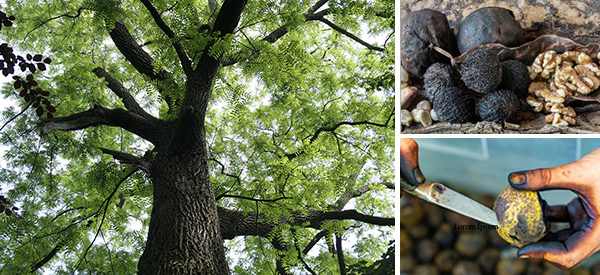
The Killer Tree You Should Never Have In Your Backyard
As an herbalist, I spend a lot of time planning the plants I want in my garden. And not so much time thinking about what I don’t want. However, it’s equally important to know what potentially dangerous plants you may have lurking in your backyard. Keep reading to learn about the killer trees you don’t want in your backyard.
If you like nuts, you might be considering planting a walnut tree in your yard. Walnut trees are great shade trees known for their beautiful wood and edible nuts. But be careful which variety of walnut you choose. Six varieties grow in the US. Make sure you avoid the Black Walnut, Juglans nigra. Here’s why.
Why is it bad?
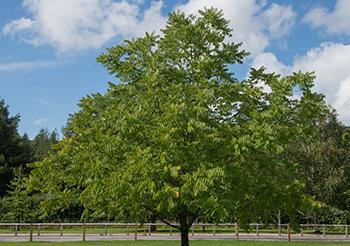 Black Walnut produces a chemical in its leaves, trunk, and roots called juglone. Juglone can cause damage or death to plants. While juglone is present in all walnut trees, the highest concentrations appear in the Black Walnut variety. Juglone helps protect walnut trees from other plants that may be competing for the same resources. So, while this is good for the Black Walnut tree, it is bad for you if you want to grow plants close by it. Juglone is concentrated in the soil beneath the drip line of the tree. The drip line is the area from the trunk to the edge of the branches. In a mature black walnut tree that can span 50 feet!
Black Walnut produces a chemical in its leaves, trunk, and roots called juglone. Juglone can cause damage or death to plants. While juglone is present in all walnut trees, the highest concentrations appear in the Black Walnut variety. Juglone helps protect walnut trees from other plants that may be competing for the same resources. So, while this is good for the Black Walnut tree, it is bad for you if you want to grow plants close by it. Juglone is concentrated in the soil beneath the drip line of the tree. The drip line is the area from the trunk to the edge of the branches. In a mature black walnut tree that can span 50 feet!
Some plants are more susceptible to juglone than others. If you do have a black walnut tree avoid planting these plants close by:
Distribution
Black Walnuts are native to Eastern North America. You can find the trees as far north as Ontario and as far south as Georgia and northern Florida. Their range reaches from the Atlantic Coast as far west as South Dakota and Texas.
How to identify the Black Walnut Tree
All walnut trees have certain things in common. They are deciduous trees that can grow from 30- 131 feet tall. Their branches can span an epic 50 feet, making them a great choice for shade trees. All walnut trees produce a fruit- called a drupe- that contains an edible nut inside. In fact, those walnuts aren’t really nuts at all. They are the seeds of the fruit.
There are six different varieties of walnuts growing in the US. Black Walnut, along with English Walnut, is amongst the most common. So how do you tell one walnut variety from another?
Leaves
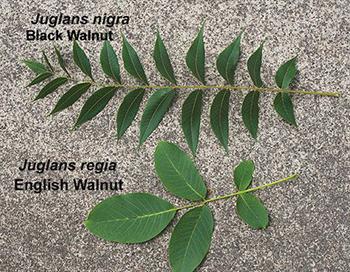 All species of walnuts have feathery pinnate leaves. The black walnut has between 15-23 leaflets on each twig. They are in pairs. The black walnut doesn’t have the extra leaf at the tip that other varieties have.
All species of walnuts have feathery pinnate leaves. The black walnut has between 15-23 leaflets on each twig. They are in pairs. The black walnut doesn’t have the extra leaf at the tip that other varieties have.
This leaf is the easiest way to distinguish black walnut from other species. When the black walnut does have a terminal leaf, it is small. The similar English and butternut walnuts always have a large terminal leaf.
Trunk
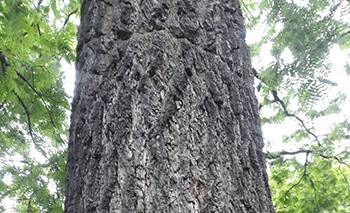 Black walnut bark is dark and deeply fissured. If you remove the bark, you can see the dark brown wood beneath it. The bark on the black walnut is darker than the bark on other walnut varieties. The deep ridges in the bark are the most distinctive feature of this tree in winter. You can see diamond-shaped patterns in the ridges in the bark.
Black walnut bark is dark and deeply fissured. If you remove the bark, you can see the dark brown wood beneath it. The bark on the black walnut is darker than the bark on other walnut varieties. The deep ridges in the bark are the most distinctive feature of this tree in winter. You can see diamond-shaped patterns in the ridges in the bark.
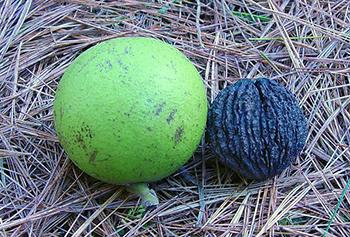
Nuts
The nuts’ shape varies depending on which variety of walnut you have.
Black walnuts are round rather than oval like the butternut variety. Black walnuts also have the hardest shells.
Benefits
If you do have a black walnut tree, it is not all bad. There are benefits of having this tree in your yard. The main one is the delicious nuts.
Walnuts are high in antioxidants and Omega-3s. This can help improve any inflammatory conditions you may have. They also have been shown to help with brain health, diabetes, high blood pressure, and high cholesterol. They are easy to add to your diet. You can snack on just walnuts or try adding them to your food. They are great in salads, trail mix, with fruit or vegetables. The possibilities are endless.
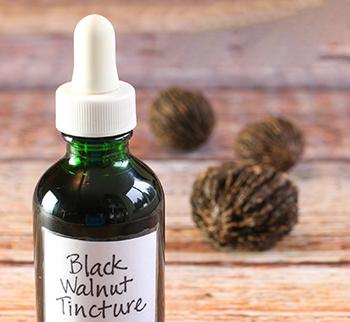
There are also many ways to use walnuts besides eating them. The wood is beautiful and strong, so it is a popular choice. Walnut oil can be eaten or used to make non-toxic oil-based paints. The hulls have many uses as well. They can be used as a dye, ground up and added to cosmetics, or used medicinally as an anti-parasitic.
So while walnuts can be killer to your plants, they have many beneficial uses as well. Unlike the Manchineel tree, which I’ll talk about next.
Manchineel Tree
 The manchineel tree, Hippomane mancinella, is native to the tropical regions of southern North America and northern South America. In the US, it is found only in Florida. It grows mostly along beaches or in swampy areas. It grows as tall as 50 feet tall and has fruit that resembles small green apples.
The manchineel tree, Hippomane mancinella, is native to the tropical regions of southern North America and northern South America. In the US, it is found only in Florida. It grows mostly along beaches or in swampy areas. It grows as tall as 50 feet tall and has fruit that resembles small green apples.
Because of these fruits, it is also called manzanilla de la muerte in Spanish, which translates to “little apple of death.” When it comes to toxic trees, this tree is one of the most toxic in the world. The sap is the real problem. The milky white fluid contains numerous poisons and is present in all parts of the tree. This burning sap is so toxic that simply standing under the tree during a rainstorm can cause blistering as the sap dissolves into the rain. Eating the fruit can cause death.
When planning your garden, remember to pay as much attention to the killer trees as you do to the beneficial plants. Some killer trees, like black walnut, may have benefits you decide outweigh the risks. Others, like the manchineel tree, are so toxic it’s best to avoid them together.
You may also like:
 If You Have This Tree in Your Backyard, Don’t Cut it Down!
If You Have This Tree in Your Backyard, Don’t Cut it Down!
Similar to Morphine: The Best Natural Painkiller that Grows in Your Backyard (Video)
How To Treat Varicose Veins With Chestnuts









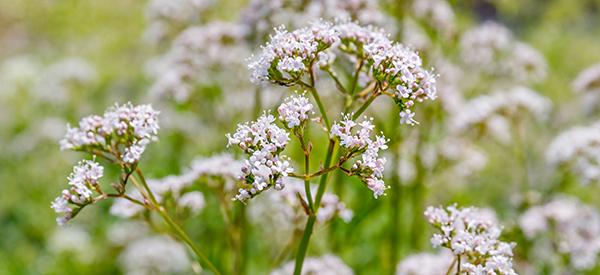
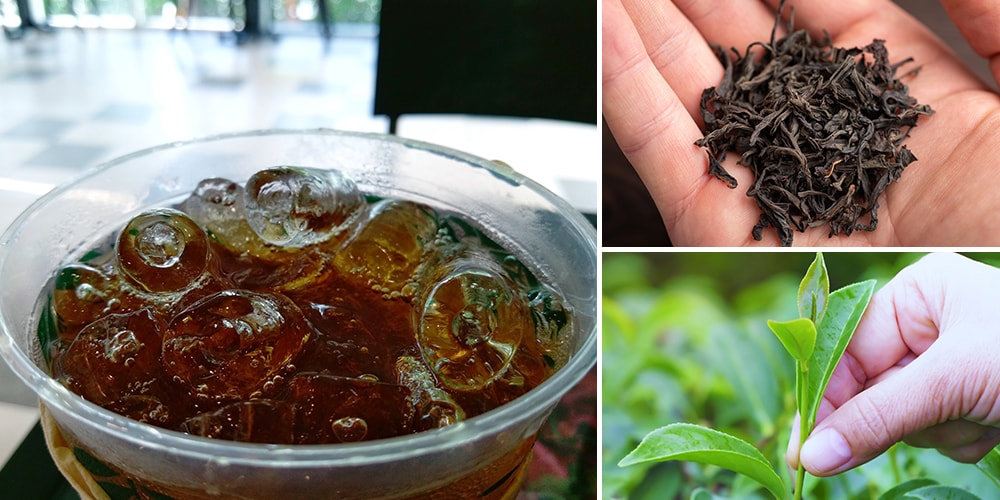
I read somewhere that the Black Walnut hull contained
iodine-one of the few non-ocean living plants to contain it.
Can the iodine be extracted from the hull-fruit???
Other plants, non-ocean, that contain iodine???
Thank in advance. -Great information.
iodine is found in eggs, baked potato [skin and all], cod and some grains, if I remember correctly. Sea weed has the most, but there are other foods that contain it also.
Anything natural you can use for Rheumatoid arthritis?
Hi Julie,
The following herbs have anti-inflammatory properties that can help with rheumatoid arthritis: Aloe Vera, Cat’s Claw, Eucalyptus, Ginger, Green Tea, Turmeric, Willow Bark. Be sure to talk to a doctor first, as some options may interact with existing medications.
Also, don’t forget about weight management, exercise, cold and heat treatment, stress management, and a healthy diet.
God bless!
Look up studies that have been done that uses Minocycline and Hydroxychloquine at low doses over a long period of time, well over a year. This will eventually kill the mycoplasma that is causing the disease.
Manchineel can also adversely affect people with allergies! Medicinally, black walnut trees are very important. Both the bark and shell hulls have been used for hundreds if not thousands of years to eradicate fungal infections. Internally, we use it with garlic and pennyroyal to expel intestinal worms. Commercially, black walnut is one of the most sought after (and expensive) lumbers. It is used for fireplace mantles, ornamental bowls, and of course woodstock for rifles.
Can you share your recipe to expel worms?
Can anyone confirm that Black Walnut trees attract lightening? And not just due to height.
There were 5 Black Walnut trees along our property line, just inside the neighbor’s yard, all under 20 ft tall. There are 60+ ft tall maples, a very large conifer, white & river birch, a large locust and a standard size apple tree. Of all our trees, and I’ve been here 29 years, in Minnesota, with lots of lightning storms; the locust tree was hit twice by lightning and the apple tree once. Lightning never touched the other trees. I have no idea about the statistics. I can tell you that Black Walnut trees are such a mess. Squirrels are constantly bury the nuts everywhere, propagating new trees, the green husks they peel away, stains decks and concrete.
I found this article very interesting. I appreciate the info. Thanks again
Hi Lydia,
Thank you for your comment.
I am glad to hear you found our article interesting.
God bless!
Great info!!!!
Uhh, not so much. My maples kill far more under them than my black walnuts. My garden is growing in the shade (under the drip line) of a dozen black walnuts and has been doing quite well for a number of years.
Hi Russ,
Thank you for sharing this with us.
I am glad to hear that your garden is doing well in the shade of the black walnut trees.
God bless!
Interesting..always good to hear outliers.
Or sometimes even out and out liars?
Last year I planted 4-yr old healthy apple trees within 30 feet of a black walnut. Branches started dying and they began to languish. I had a vague memory of hearing about certain trees claiming their territory and killing other plants, so I did a little research and found out about juglone. I read that stone fruits – cherries, nectarines, peaches, plums – are not affected. So I moved the apples about 150+feet away to a safe spot and put nectarines in their place. It has been close to a year now since the move. The apple trees seem happy and healthy now that they are no longer near the black walnut, and the nectarines are showing no ill effects being closer to it. It should be noted that they are within 50 feet, but not within its drip line.
Hi V.
Thank you so much for sharing your experience with us.
I am glad to hear that your apple trees seem happy now 🙂
God bless!
I agree they are troubling but we have a dozen Black Walnut trees and have learned what grows under them including my favorites, the Hellebores that thrive under black walnut trees, as do heuchera (coral bells), daffodils, mosses, ferns and several bushes. I’d not be so quick to label them as “don’t have them in your backyard”, they are very pretty and a valuable natural resource.
Good information, but I agree with Michelle, I cringed at the alarmist tone of the headline “killer trees” because BW’s are awesome trees.
I used the tincture of Black Walnut before used in combination with other herbs for parasite treatment. This was part of Hulda Clark’s regimen. It works well and easy to make your own.
Our property has 5 neighboring black walnut trees, they are a mess from spring to fall and our vegetable garden does not do well as a result of the juglone. Very frustrating for us!!